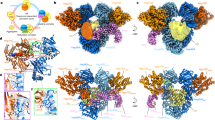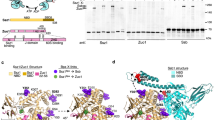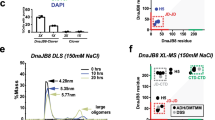Abstract
Cochaperones are essential for Hsp70- and Hsc70-mediated folding of proteins and include nucleotide-exchange factors (NEFs) that assist protein folding by accelerating ADP-ATP exchange on Hsp70. The cochaperone Bag2 binds misfolded Hsp70 clients and also acts as an NEF, but the molecular basis for its function is unclear. We show that, rather than being a member of the Bag domain family, Bag2 contains a new type of Hsp70 NEF domain, which we call the 'brand new bag' (BNB) domain. Free and Hsc70-bound crystal structures of Bag2-BNB show its dimeric structure, in which a flanking linker helix and loop bind to Hsc70 to promote nucleotide exchange. NMR analysis demonstrates that the client binding sites and Hsc70-interaction sites of the Bag2-BNB overlap, and that Hsc70 can displace clients from Bag2-BNB, indicating a distinct mechanism for the regulation of Hsp70-mediated protein folding by Bag2.
This is a preview of subscription content, access via your institution
Access options
Subscribe to this journal
Receive 12 print issues and online access
$189.00 per year
only $15.75 per issue
Buy this article
- Purchase on Springer Link
- Instant access to full article PDF
Prices may be subject to local taxes which are calculated during checkout






Similar content being viewed by others
References
Mayer, M.P. & Bukau, B. Hsp70 chaperones: cellular functions and molecular mechanism. Cell. Mol. Life Sci. 62, 670–684 (2005).
Morano, K.A. New tricks for an old dog: the evolving world of Hsp70. Ann. NY Acad. Sci. 1113, 1–14 (2007).
Qiu, X.B., Shao, Y.M., Miao, S. & Wang, L. The diversity of the DnaJ/Hsp40 family, the crucial partners for Hsp70 chaperones. Cell. Mol. Life Sci. 63, 2560–2570 (2006).
Cyr, D.M. Swapping nucleotides, tuning Hsp70. Cell 133, 945–947 (2008).
Young, J.C., Barral, J.M. & Ulrich Hartl, F. More than folding: localized functions of cytosolic chaperones. Trends Biochem. Sci. 28, 541–547 (2003).
Takayama, S. & Reed, J.C. Molecular chaperone targeting and regulation by BAG family proteins. Nat. Cell Biol. 3, E237–E241 (2001).
Takayama, S., Xie, Z. & Reed, J.C. An evolutionarily conserved family of Hsp70/Hsc70 molecular chaperone regulators. J. Biol. Chem. 274, 781–786 (1999).
Sondermann, H. et al. Structure of a Bag/Hsc70 complex: convergent functional evolution of Hsp70 nucleotide exchange factors. Science 291, 1553–1557 (2001).
Arndt, V., Daniel, C., Nastainczyk, W., Alberti, S. & Hohfeld, J. BAG-2 acts as an inhibitor of the chaperone-associated ubiquitin ligase CHIP. Mol. Biol. Cell 16, 5891–5900 (2005).
Dai, Q. et al. Regulation of the cytoplasmic quality control protein degradation pathway by BAG2. J. Biol. Chem. 280, 38673–38681 (2005).
Briknarova, K. et al. Structural analysis of BAG1 cochaperone and its interactions with Hsc70 heat shock protein. Nat. Struct. Biol. 8, 349–352 (2001).
Kleinjung, J. & Fraternali, F. POPSCOMP: an automated interaction analysis of biomolecular complexes. Nucleic Acids Res. 33, W342–W346 (2005).
Flaherty, K.M., DeLuca-Flaherty, C. & McKay, D.B. Three-dimensional structure of the ATPase fragment of a 70K heat-shock cognate protein. Nature 346, 623–628 (1990).
Jiang, J., Prasad, K., Lafer, E.M. & Sousa, R. Structural basis of interdomain communication in the Hsc70 chaperone. Mol. Cell 20, 513–524 (2005).
Harrison, C.J., Hayer-Hartl, M., Di Liberto, M., Hartl, F. & Kuriyan, J. Crystal structure of the nucleotide exchange factor GrpE bound to the ATPase domain of the molecular chaperone DnaK. Science 276, 431–435 (1997).
Polier, S., Dragovic, Z., Hartl, F.U. & Bracher, A. Structural basis for the cooperation of Hsp70 and Hsp110 chaperones in protein folding. Cell 133, 1068–1079 (2008).
Shomura, Y. et al. Regulation of Hsp70 function by HspBP1: structural analysis reveals an alternate mechanism for Hsp70 nucleotide exchange. Mol. Cell 17, 367–379 (2005).
Schuermann, J.P. et al. Structure of the Hsp110:Hsc70 nucleotide exchange machine. Mol. Cell 31, 232–243 (2008).
Gassler, C.S., Wiederkehr, T., Brehmer, D., Bukau, B. & Mayer, M.P. Bag-1M accelerates nucleotide release for human Hsc70 and Hsp70 and can act concentration-dependent as positive and negative cofactor. J. Biol. Chem. 276, 32538–32544 (2001).
Meacham, G.C., Patterson, C., Zhang, W., Younger, J.M. & Cyr, D.M. The Hsc70 co-chaperone CHIP targets immature CFTR for proteasomal degradation. Nat. Cell Biol. 3, 100–105 (2001).
Younger, J.M. et al. Sequential quality-control checkpoints triage misfolded cystic fibrosis transmembrane conductance regulator. Cell 126, 571–582 (2006).
Li, J., Qian, X. & Sha, B. The crystal structure of the yeast Hsp40 Ydj1 complexed with its peptide substrate. Structure 11, 1475–1483 (2003).
Hu, J. et al. The crystal structure of the putative peptide-binding fragment from the human Hsp40 protein Hdj1. BMC Struct. Biol. 8, 3 (2008).
Liu, Q. & Hendrickson, W.A. Insights into Hsp70 chaperone activity from a crystal structure of the yeast Hsp110 Sse1. Cell 131, 106–120 (2007).
Siegert, R., Leroux, M.R., Scheufler, C., Hartl, F.U. & Moarefi, I. Structure of the molecular chaperone prefoldin: unique interaction of multiple coiled coil tentacles with unfolded proteins. Cell 103, 621–632 (2000).
Ludlam, A.V., Moore, B.A. & Xu, Z. The crystal structure of ribosomal chaperone trigger factor from Vibrio cholerae. Proc. Natl. Acad. Sci. USA 101, 13436–13441 (2004).
Ehrnsperger, M., Lilie, H., Gaestel, M. & Buchner, J. The dynamics of Hsp25 quaternary structure. Structure and function of different oligomeric species. J. Biol. Chem. 274, 14867–14874 (1999).
Haley, D.A., Horwitz, J. & Stewart, P.L. The small heat-shock protein, αb-crystallin, has a variable quaternary structure. J. Mol. Biol. 277, 27–35 (1998).
McDonough, H. & Patterson, C. CHIP: a link between the chaperone and proteasome systems. Cell Stress Chaperones 8, 303–308 (2003).
Murata, S., Chiba, T. & Tanaka, K. CHIP: a quality-control E3 ligase collaborating with molecular chaperones. Int. J. Biochem. Cell Biol. 35, 572–578 (2003).
Walker, V.E., Atanasiu, R., Lam, H. & Shrier, A. Co-chaperone FKBP38 promotes HERG trafficking. J. Biol. Chem. 282, 23509–23516 (2007).
Sheffield, P., Garrard, S. & Derewenda, Z. Overcoming expression and purification problems of RhoGDI using a family of “parallel” expression vectors. Protein Expr. Purif. 15, 34–39 (1999).
Pflugrath, J.W. The finer things in X-ray diffraction data collection. Acta Crystallogr. D Biol. Crystallogr. 55, 1718–1725 (1999).
Adams, P.D. et al. PHENIX: building new software for automated crystallographic structure determination. Acta Crystallogr. D Biol. Crystallogr. 58, 1948–1954 (2002).
Emsley, P. & Cowtan, K. Coot: model-building tools for molecular graphics. Acta Crystallogr. D Biol. Crystallogr. 60, 2126–2132 (2004).
Brunger, A.T. et al. Crystallography & NMR system: a new software suite for macromolecular structure determination. Acta Crystallogr. D Biol. Crystallogr. 54, 905–921 (1998).
McCoy, A.J. et al. Phaser crystallographic software. J. Appl. Crystallogr. 40, 658–674 (2007).
Baker, N.A., Sept, D., Joseph, S., Holst, M.J. & McCammon, J.A. Electrostatics of nanosystems: application to microtubules and the ribosome. Proc. Natl. Acad. Sci. USA 98, 10037–10041 (2001).
Delaglio, F. et al. NMRPipe: a multidimensional spectral processing system based on UNIX pipes. J. Biomol. NMR 6, 277–293 (1995).
Schleucher, J. et al. A general enhancement scheme in heteronuclear multidimensional NMR employing pulsed field gradients. J. Biomol. NMR 4, 301–306 (1994).
Grzesiek, S., Stahl, S.J., Wingfield, P.T. & Bax, A. The CD4 determinant for downregulation by HIV-1 Nef directly binds to Nef. Mapping of the Nef binding surface by NMR. Biochemistry 35, 10256–10261 (1996).
Acknowledgements
This work was funded by grants from the US National Institutes of Health (R01-GM61728 to C.P. and RO1-GM080271 to S.M.), the American Heart Association (SDG 0735313N to S.M.) and by funds from the State of Ohio Eminent Scholar Program (to A.B.H.). E.K. was supported by funds from the Ralph Wilson Medical Research Foundation. The Advanced Light Source is supported by the US Department of Energy under contract number DE-AC03-76SF00098 at Lawrence Berkeley National Laboratory.
Author information
Authors and Affiliations
Contributions
Z.X. and E.K. cloned, expressed and purified the various protein constructs; Z.X., J.C.N. and S.M. carried out crystallization, data collection and crystal structure solution; R.C.P. expressed and purified labeled proteins and carried out NMR experiments and data analysis; M.M.G. carried out analytical ultracentrifugation experiments, and M.M.G. and A.B.H. interpreted the ultracentrifugation data; E.K. and Z.X. carried out in vitro protein-protein interaction and Luciferase-refolding experiments; C.P. performed the single-turnover nucleotide-exchange assays; S.M. compiled the manuscript with contributions from Z.X., R.C.P., E.K., A.B.H. and C.P.
Corresponding author
Supplementary information
Supplementary Text and Figures
Supplementary Figures 1–5, Supplementary Table 1 and Supplementary Methods (PDF 3107 kb)
Rights and permissions
About this article
Cite this article
Xu, Z., Page, R., Gomes, M. et al. Structural basis of nucleotide exchange and client binding by the Hsp70 cochaperone Bag2. Nat Struct Mol Biol 15, 1309–1317 (2008). https://doi.org/10.1038/nsmb.1518
Received:
Accepted:
Published:
Issue Date:
DOI: https://doi.org/10.1038/nsmb.1518
This article is cited by
-
Stress routes clients to the proteasome via a BAG2 ubiquitin-independent degradation condensate
Nature Communications (2022)
-
BAG2 prevents Tau hyperphosphorylation and increases p62/SQSTM1 in cell models of neurodegeneration
Molecular Biology Reports (2022)
-
Bcl-2-associated athanogene 5 (BAG5) regulates Parkin-dependent mitophagy and cell death
Cell Death & Disease (2019)
-
Tylophorine Analogs Allosterically Regulates Heat Shock Cognate Protein 70 And Inhibits Hepatitis C Virus Replication
Scientific Reports (2017)
-
BAG2 structure, function and involvement in disease
Cellular & Molecular Biology Letters (2016)



